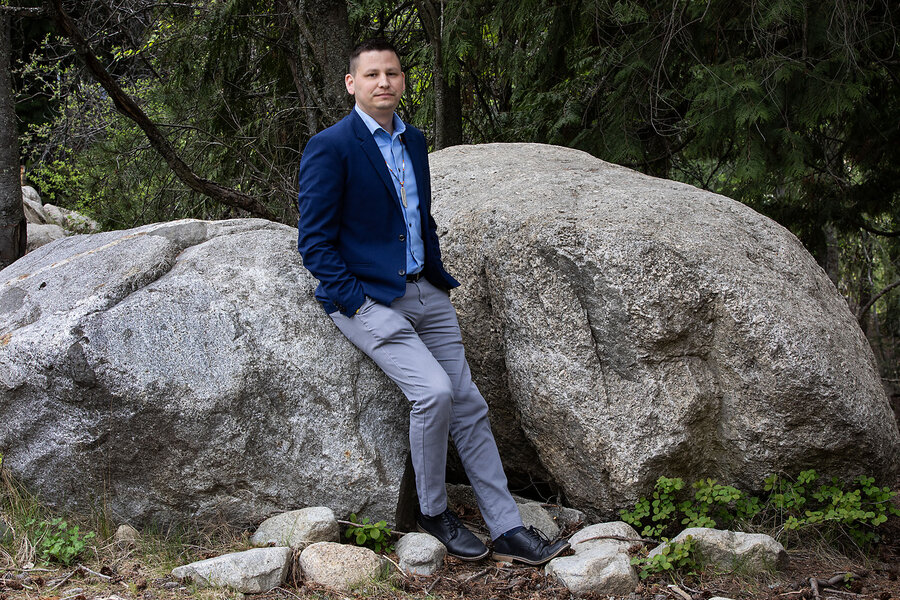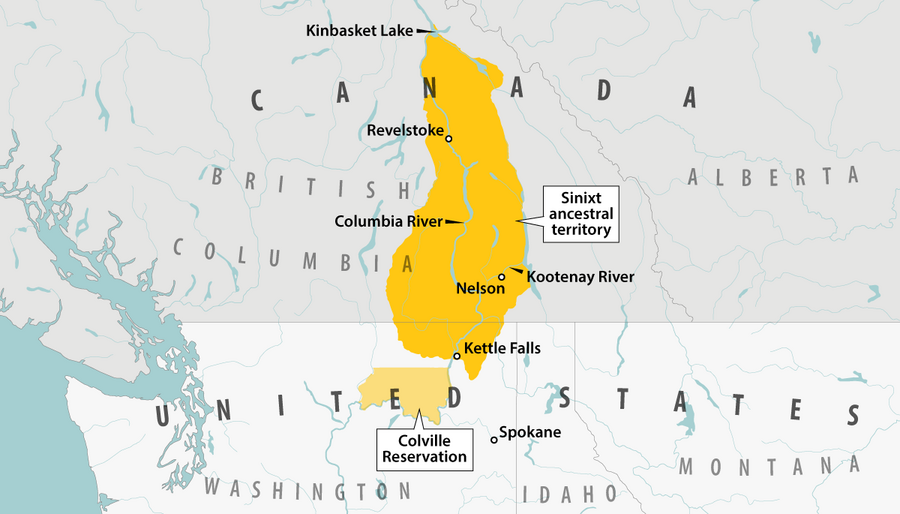
The traditional territory of the Sinixt people extends from Kinbasket Lake in British Columbia to Kettle Falls in Washington state, but most today live on the southern side of the United States-Canada border. In fact, the Canadian government declared them “extinct” in 1956.
But in 2010, Rick Desautel, a Sinixt descendant and U.S. citizen, was arrested in British Columbia for hunting without a license or being a provincial resident. He argued he was exercising his Aboriginal right to hunt in ancestral territory.
Why We Wrote This
A story focused on
When a country recognizes the rights of peoples to use their ancestral territory but they live in a different country, it raises tricky questions around access and sovereignty. That’s just what’s happening in Canada with the Sinixt Confederacy.
The Canadian Supreme Court agreed with him in 2021. It ruled that descendants of those who lived in what is now Canada prior to European contact, but without modern Canadian citizenship or residency, can be considered “Aboriginal peoples of Canada.” Specifically, the Sinixt have Canadian constitutional rights to fish, hunt, and gather on their ancestral lands.
But the ruling was just the beginning of the Sinixt’s reintroduction to Canada. Among the questions now being posed: What other rights are they entitled to? How should they be consulted on development or resource projects that go through their ancestors’ territory? Do they have the right to cross the border and live and work freely?
“We’ve opened a can of worms,” says Mr. Desautel.
Shelly Boyd descends into the depression on the banks of the Kootenay River in British Columbia.
She’s Native American, but her Sinixt ancestors once sheltered in these pit houses, or traditional Indigenous dwellings, to wait out long winters. Being here today, she says, she feels “sacredness” all around her.
She’s always been able to visit these lands in Canada, across the border from where she was born in U.S. territory. But now, after a groundbreaking Canadian Supreme Court decision, she’s more than just a tourist.
Why We Wrote This
A story focused on
When a country recognizes the rights of peoples to use their ancestral territory but they live in a different country, it raises tricky questions around access and sovereignty. That’s just what’s happening in Canada with the Sinixt Confederacy.
Members of the Lakes Tribe of the Confederated Tribes of the Colville Reservation in Washington state are now one of the “Aboriginal peoples of Canada” under the country’s constitution, with protected rights – regardless of the fact that they aren’t Canadian citizens or residents.
In many ways, their work has just begun.
It has been over three years since the case was decided, and one year since the Sinixt Confederacy, as the Sinixt people have named their branch in Canada, established a physical office in Nelson, British Columbia. Now they are on a fact-sharing and education mission with federal, provincial, and local officials in this western province to teach their ethnographic history – and find ways to formally establish themselves.
The provincial and federal governments have been slow to recognize the Sinixt – “glacial” is how their lawyer puts it. How they eventually find their place and recognition in Canada could have enormous implications for other Indigenous people across North America whose communities were disjoined by the United States-Canada border. Some of those communities are already testing the new rights conferred by the ruling.
“Borders don’t define us,” says Jarred-Michael Erickson, chair of the Confederated Tribes of the Colville Reservation on the sidelines of a conference the Sinixt Confederacy held in Nelson with local stakeholders. “The border is an imaginary line that the Canadian and U.S. governments made up, and all of a sudden we were stuck on one side of it.”
Until now.
Reunited with their ancestors’ land
This fight started with an elk hunt.
Many Sinixt, whose traditional territory extends from Kinbasket Lake north of Revelstoke in British Columbia southward to Kettle Falls in Washington, today reside on the U.S. side of the border on the Colville Reservation. The Canadian government declared them “extinct” in 1956.
More than 50 years later, Rick Desautel, a member of the Confederated Tribes of the Colville Reservation and a U.S. citizen, shot a cow elk for ceremonial meat in British Columbia in a strategic effort to get arrested. It was 2010, and he was charged for not having a license and for hunting big game without being a provincial resident. In his defense, he argued he was exercising his Aboriginal right to hunt in ancestral territory.
His case drew support from over a dozen cross-border groups and other Indigenous organizations. Mr. Desautel won three successive victories in the lower courts, and in 2021, a majority of Canada’s Supreme Court agreed with him, too. The court effectively ruled that Indigenous people who are descendants of those who lived in what is now Canada prior to European contact, but without modern Canadian citizenship or residency, can be considered “Aboriginal peoples of Canada.” To deny that right, the court ruled, would “risk perpetuating the historical injustice suffered by Aboriginal peoples at the hands of Europeans.”
It also reverses the ruling on the Sinixt’s extinction. “If we’d lost, it would have just wiped us out of this country,” says Mr. Desautel in an interview in Nelson. Specifically, the case affirmed that the Sinixt have Canadian constitutional rights to fish, hunt, and gather on their ancestral lands.
But, he adds, “we’ve opened a can of worms.”
Among the questions now being posed: What other rights are they entitled to as one of the “Aboriginal peoples of Canada”? How should they be consulted on development or resource projects that go through their ancestors’ territory? Do they have the right to cross the border and live and work freely?
Among the biggest questions right now, says Mark Underhill, the lawyer who represented the Sinixt at the Supreme Court, is how many other transborder groups in the U.S. will try to establish rights in Canada. Already, seven tribes in Alaska have sought a say in a mining project in northern British Columbia, citing the Desautel case.
That’s why the case was so contentious to begin with. Six provinces and territories that border the U.S. intervened against the Sinixt. Attorneys argued that granting rights to non-Canadian citizens outside Canada would be incompatible with Canadian sovereignty.
“If Indigenous Mexicans tried to interfere with California’s internal affairs, there would be outcry [in the U.S.] against foreigners trying to interfere,” says Peter Best, a retired lawyer in the mining community of Sudbury, Ontario, who has written against this case.
A mixed reception up north?
The new Sinixt office in Nelson primarily deals with fish and wildlife services. And for the most part, the Sinixt say they feel welcome in this liberal town that has traditionally drawn artists and Americans escaping the draft during the Vietnam War.
“We have been working very diligently in ‘Truth and Reconciliation,’” says Mayor Janice Morrison, referring to the Canadian government’s framework, under Prime Minister Justin Trudeau, for justice for Indigenous peoples across Canada. She sees this fight as part of their town’s Reconciliation work.
But much confusion remains. James Baxter, a biologist who is non-Indigenous and runs the Sinixt Nelson office, says that the Sinixt should be consulted on development work under the constitution, but aren’t in the consultative databases as they should be. “If someone wants to build a gravel pit in Nelson [right now], the Sinixt Confederacy isn’t going to come up as one of the groups they have to engage with.”
Cindy Marchand, who sits on the Colville Business Council and was the second tribe member to hunt on Canadian soil, says the fight to establish themselves has been slow. “We are still fighting tooth and nail just to be recognized up here,” she says.
They’ve come against some opponents, including other Indigenous groups in the area skeptical of their rights claims. The Sinixt, or other transnational peoples, could face opposition over future development and resource extraction, too.
“It’s almost like with any relationship you have – in order to develop and grow it, you have to have conversations. And that’s where we’re at right now,” Ms. Marchand says. “Sometimes we’re welcome, and sometimes we’re not. And unfortunately we’re not welcomed even by other First Nations.”
Ms. Boyd says that despite all the pejorative terms that Indigenous people have been called in the past, a new one has emerged after the Supreme Court ruling: “American Indian.”
She remains undeterred. This is not about power or money, she says. “We want to be consulted on what happens with land issues, and that we will have input and a hand in what happens here,” she explains. “It doesn’t mean that you’re owning [the land]. It means you’re taking care of it.”
Ms. Boyd says, “All we ever really wanted was to come home.”





